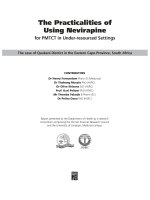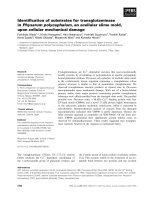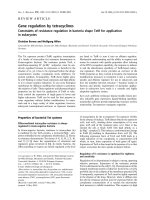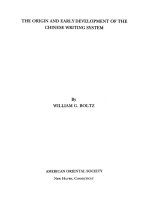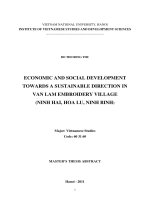nvestigating the influences of tidal inundation and surface elevation on the establishment and early development of mangroves for application in understanding mangrove rehabilitation techniques 1 7
Bạn đang xem bản rút gọn của tài liệu. Xem và tải ngay bản đầy đủ của tài liệu tại đây (3.97 MB, 15 trang )
References
Akaike, H. (1974). A new look at the statistical model identification. Institute of
Electrical and Electronics Engineers Transactions on Automatic Control, 19, 716–
723.
Alleman, L. K., & Hester, M. W. (2011). Refinement of the fundamental niche of
black mangrove (Avicennia germinans) seedlings in Louisiana: Applications for
restoration. Wetlands Ecology and Management, 19(1), 47-60.
Allen, J. A., Krauss, K. W., & Hauff, R. D. (2003). Factors limiting the intertidal
distribution of the mangrove species Xylocarpus granatum. Oecologia, 135(1), 110121.
Alongi, D. M. (2002). Present state and future of the world's mangrove
forests.Environmental conservation, 29(03), 331-349.
Anand, M., & Desrochers, R. E. (2004). Quantification of restoration success using
complex systems concepts and models. Restoration Ecology, 12(1), 117-123.
Aronson, J., Floret, C., Floc'h, E., Ovalle, C., & Pontanier, R. (1993). Restoration and
rehabilitation of degraded ecosystems in arid and semi‐arid lands. I. A View from the
South. Restoration ecology, 1(1), 8-17.
Balke, T., Bouma, T. J., Horstman, E. M., Webb, E. L., Erftemeijer, P. L., & Herman,
P. M. (2011). Windows of opportunity: thresholds to mangrove seedling establishment
on tidal flats. Marine Ecology Progress Series, 440, 1- 9.
Balke, T., Webb, E. L., den Elzen, E., Galli, D., Herman, P. M., & Bouma, T. J.
(2013). Seedling establishment in a dynamic sedimentary environment: a conceptual
framework using mangroves. Journal of Applied Ecology, 50(3), 740-747.
Ball, M. C. (2002). Interactive effects of salinity and irradiance on growth:
implications for mangrove forest structure along salinity gradients. Trees, 16(2-3),
126-139.
Barbier, E. B. (2006). Natural barriers to natural disasters: replanting mangroves after
the tsunami. Frontiers in Ecology and the Environment, 4(3): 124–131.
Barbier, E. B. (2007). Valuing ecosystem services as productive inputs. Economic
Policy, 22(49), 177-229.
76
Barbier, E., & Cox, M. (2002). Economic and demographic factors affecting mangrove
loss in the coastal provinces of Thailand, 1979-1996. AMBIO: A Journal of the Human
Environment, 31(4), 351-357.
Benayas, J. M. R., Newton, A. C., Diaz, A., & Bullock, J. M. (2009). Enhancement of
biodiversity and ecosystem services by ecological restoration: a metaanalysis. Science, 325 (5944), 1121-1124.
Biber, P. D. (2006). Measuring the effects of salinity stress in the red mangrove,
Rhizophora mangle L. African Journal of Agricultural Research, 1(1), 1-4.
Biswas, S. R., & Choudhury, J. K. (2007). Forests and Forest Management Practices in
Bangladesh: The Question of Sustainability 1. International Forestry Review, 9(2),
627-640.
Biswas, S. R., Mallik, A. U., Choudhury, J. K., & Nishat, A. (2009). A unified
framework for the restoration of Southeast Asian mangroves – bridging ecology,
society and economics. Wetlands Ecology and Management, 17(4), 365-383.
Borja, Á.,Dauer, D. M., Elliott, M., & Simenstad, C. A. (2010). Medium-and longterm recovery of estuarine and coastal ecosystems: patterns, rates and restoration
effectiveness. Estuaries and Coasts, 33(6), 1249-1260.
Bosire, J. O., Dahdouh-Guebas, F., Kairo, J. G., & Koedam, N. (2003). Colonization
of non-planted mangrove species into restored mangrove stands in Gazi Bay,
Kenya. Aquatic Botany, 76(4), 267-279.
Bosire, J. O., Dahdouh-Guebas, F., Walton, M., Crona, B. I., Lewis III, R. R., Field,
C., ... & Koedam, N. (2008). Functionality of restored mangroves: a review. Aquatic
Botany, 89(2), 251-259.
Bradley, C. E., & Smith, D. G. (1986). Plains cottonwood recruitment and survival on
a prairie meandering river floodplain, Milk River, southern Alberta and northern
Montana. Canadian Journal of Botany, 64(7), 1433-1442.
Brockmeyer Jr, R. E., Rey, J. R., Virnstein, R. W., Gilmore, R. G., & Earnest, L.
(1996). Rehabilitation of impounded estuarine wetlands by hydrologic reconnection to
the Indian River Lagoon, Florida (USA). Wetlands Ecology and Management, 4(2),
93-109.
Brown, B., Fadillah, R., Nurdin, Y., Soulsby, I., & Ahmad, R. (2014, 02 September).
Community Based Ecological Mangrove Rehabilitation (CBEMR) in Indonesia.
S.A.P.I.EN.S [Online article] Retrieved from />Brown, B., & Lewis, R. R., (2006) Five steps to successful ecological restoration of
mangroves. Yayasam Alar Rumput Laut (YARL) and the Mangrove Action Project,
Indonesia: Yogyakarta: 64 pp.
77
Burke, L., Kura, Y., Kassem, K., Revenga, C., Spalding, M. & McAllister, D. (2001)
Pilot Analysis of Global Ecosystems: Coastal Ecosystems. Washington, DC, USA:
World Resources Institute: 77 pp.
Cardona-Olarte, P., Twilley, R. R., Krauss, K. W., & Rivera-Monroy, V. (2006).
Responses of neotropical mangrove seedlings grown in monoculture and mixed culture
under treatments of hydroperiod and salinity. Hydrobiologia, 569(1), 325-341.
Castañeda-Moya, E., Twilley, R. R., Rivera-Monroy, V. H., Marx, B. D., CoronadoMolina, C., & Ewe, S. M. (2011). Patterns of root dynamics in mangrove forests along
environmental gradients in the Florida Coastal Everglades, USA. Ecosystems, 14(7),
1178-1195.
Chen, B., Yu, W., Liu, W., & Liu, Z. (2012). An assessment on restoration of typical
marine ecosystems in china–Achievements and lessons. Ocean & Coastal
Management, 57, 53-61.
Chen, G. C., Ye, Y., & Lu, C. Y. (2007). Changes of macro-benthic faunal community
with stand age of rehabilitated Kandelia candel mangrove in Jiulongjiang Estuary,
China. Ecological Engineering, 31(3), 215-224.
Chen, L., Tam, N. F., Wang, W., Zhang, Y., & Lin, G. (2013). Significant niche
overlap between native and exotic Sonneratia mangrove species along a continuum of
varying inundation periods. Estuarine, Coastal and Shelf Science, 117, 22-28.
Chen, L., Wang, W., Zhang, Y., & Lin, G. (2009). Recent progresses in mangrove
conservation, restoration and research in China. Journal of Plant Ecology, 2(2), 45-54.
Chen, L. Z., Wang, W. Q. & Lin, P. (2005). Photosynthetic and physiological
responses of Kandelia candel L. Druce seedling to duration of tidal immersion in
artificial seawater. Environmental and Experimental Botany, 54, 256–266.
Christiansen, C., & Møller, J. T. (1983). Rate of establishment and seasonal immersion
of Spartina in Mariager Fjord, Denmark. Ecography, 6(3), 315-319.
Cintrón-Molero, G., & Schaeffer-Novelli, Y. (1992). Ecology and management of
New World mangroves. Coastal plant communities of Latin America, 233-258.
Cintrón, G., Lugo, A. E., Pool, D. J., & Morris, G. (1978). Mangroves of arid
environments in Puerto Rico and adjacent islands. Biotropica, 110-121.
Clarke, P. J. (1993). Dispersal of grey mangrove (Avicennia marina) propagules in
southeastern Australia. Aquatic Botany, 45(2), 195-204.
78
Clarke, P. J., & Myerscough, P. J. (1993). The intertidal distribution of the grey
mangrove (Avicennia marina) in southeastern Australia: the effects of physical
conditions, interspecific competition, and predation on propagule establishment and
survival. Australian Journal of Ecology, 18(3), 307-315.
Clarke, P. J. (2004) Effects of experimental canopy gaps on mangrove recruitment:
lack of habitat partitioning may explain stand dominance. Journal of Ecology, 92,
203–213.
Crase, B., Liedloff, A., Vesk, P. A., Burgman, M. A., & Wintle, B. A. (2013).
Hydroperiod is the main driver of the spatial pattern of dominance in mangrove
communities. Global Ecology and Biogeography, 22(7), 806-817.
Dale, P. E. R., Knight, J. M., & Dwyer, P. G. (2014). Mangrove rehabilitation: a
review focusing on ecological and institutional issues. Wetlands Ecology and
Management, 22(6), 587-604.
De Haan, J. H. (1931). Het een en ander over de Tijlatjapsche vloedbosschen Tectona,
24, 39-75.
Delgado, P., Hensel, P. F., Jiménez, J. A., & Day, J. W. (2001). The importance of
propagule establishment and physical factors in mangrove distributional patterns in a
Costa Rican estuary. Aquatic Botany, 71(3), 157-178.
Donato, D. C., Kauffman, J. B., Murdiyarso, D., Kurnianto, S., Stidham, M., &
Kanninen, M. (2011). Mangroves among the most carbon-rich forests in the
tropics. Nature Geoscience, 4(5), 293-297.
Elliott, M., D. Burdon, K.L. Hemingway, & S.E. Apitz. (2007). Estuarine, coastal and
marine ecosystem restoration: Confusing management and science – A revision of
concepts. Estuarine, Coastal and Shelf Science, 74, 349–366.
Ellison, A. M., & Farnsworth, E. J. (1993). Seedling survivorship, growth, and
response to disturbance in Belizean mangal. American Journal of Botany, 80(10),
1137-1145.
Ellison, A. M., & Farnsworth, E. J. (1997). Simulated sea level change alters anatomy,
physiology, growth, and reproduction of red mangrove (Rhizophora mangle
L.). Oecologia, 112(4), 435-446.
Ellison, A. M. (2000). Mangrove restoration: do we know enough? Restoration
Ecology, 8(3), 219-229.
79
Elmqvist, T. & Cox, P. A. (1996). The evolution of vivipary in flowering plants.
Oikos, 77, 3 – 9.
Elster, C. (2000). Reasons for reforestation success and failure with three mangrove
species in Colombia. Forest Ecology and Management, 131(1), 201-214.
Erftemeijer, P. L., & Lewis, R. R. (1999, May). Planting mangroves on intertidal
mudflats: habitat restoration or habitat conversion. In Proceedings of the ECOTONE
VIII seminar enhancing coastal ecosystems restoration for the 21st century, Ranong,
Thailand. Pp. 23-28.
Field, C. D. (1999). Rehabilitation of mangrove ecosystems: an overview. Marine
Pollution Bulletin, 37(8), 383-392.
Flaherty, M., & Karnjanakesorn, C. (1995). Marine shrimp aquaculture and natural
resource degradation in Thailand. Environmental Management, 19(1), 27-37.
Foote, A. L., & Kadlec, J. A. (1988). Effects of wave energy on plant establishment in
shallow lacustrine wetlands. Journal of Freshwater Ecology, 4(4), 523-532.
Friess, D. A., Krauss, K. W., Horstman, E. M., Balke, T., Bouma, T. J., Galli, D., &
Webb, E. L. (2012). Are all intertidal wetlands naturally created equal? Bottlenecks,
thresholds and knowledge gaps to mangrove and saltmarsh ecosystems. Biological
Reviews, 87(2), 346-366.
Furukawa, K., Wolanski, E., & Mueller, H. (1997). Currents and sediment transport in
mangrove forests. Estuarine, Coastal and Shelf Science, 44(3), 301-310.
Gilman, E., & Ellison, J. (2007). Efficacy of alternative low-cost approaches to
mangrove restoration, American Samoa. Estuaries and Coasts, 30(4), 641-651.
Gilman, E. L., Ellison, J., Duke, N. C., & Field, C. (2008). Threats to mangroves from
climate change and adaptation options: a review. Aquatic Botany, 89(2), 237-250.
Giri, C., Ochieng, E., Tieszen, L. L., Zhu, Z., Singh, A., Loveland, T., ... & Duke, N.
(2011). Status and distribution of mangrove forests of the world using earth
observation satellite data. Global Ecology and Biogeography, 20(1), 154-159.
Harun-or-Rashid, S., Biswas, S. R., Böcker, R., & Kruse, M. (2009). Mangrove
community recovery potential after catastrophic disturbances in Bangladesh. Forest
ecology and management, 257(3), 923-930.
He, B., Lai, T., Fan, H., Wang, W., & Zheng, H. (2007). Comparison of floodingtolerance in four mangrove species in a diurnal tidal zone in the Beibu Gulf. Estuarine,
Coastal and Shelf Science, 74(1), 254-262.
80
Hilderbrand, R. H., Watts, A. C., & Randle, A. M. (2005). The myths of restoration
ecology. Ecology and Society, 10(1), 19.
Hoang Tri, N., Adger, W. N., & Kelly, P. M. (1998). Natural resource management in
mitigating climate impacts: the example of mangrove restoration in Vietnam. Global
Environmental Change, 8(1), 49-61.
Hobbs, R. J., & Norton, D. A. (1996). Towards a conceptual framework for restoration
ecology. Restoration ecology, 4(2), 93-110.
Hobbs, R. J., & J. A. Harris. (2001). Restoration ecology: repairing the earth’s
ecosystems in the new millennium. Restoration Ecology, 9, 239–246.
Holl, K. D., Stout, V. M., Reid, J. L., & Zahawi, R. A. (2013). Testing heterogeneity–
diversity relationships in tropical forest restoration. Oecologia,173(2), 569-578.
Holling, C. S. (1978). Adaptive environmental assessment and management. London:
Wiley.
Hoppe-Speer, S. C., Adams, J. B., Rajkaran, A., & Bailey, D. (2011). The response of
the red mangrove Rhizophora mucronata Lam. to salinity and inundation in South
Africa. Aquatic Botany, 95(2), 71-76.
Hossain, M., Lin, C. K., & Hussain, M. Z. (2001). Goodbye Chakaria Sunderban: the
oldest mangrove forest. The Society of Wetland Scientists Bulletin, 18(3), 19-22.
Hovenden, M. J., Curran, M., Cole, M. A., Goulter, P. F. E., Skelton, N. J., & Allaway,
W. G. (1995). Ventilation and respiration in roots of one-year-old seedlings of grey
mangrove Avicennia marina (Forsk.) Vierh. Hydrobiologia, 295, 23 – 29.
Hubbard, J. C. E., & Partridge, T. R. (1981). Tidal immersion and the growth of
Spartina anglica marshes in the Waihopai River Estuary, New Zealand. New Zealand
Journal of Botany, 19(1), 115-121.
Jackson, M. B., & Drew, M. C. (1984). Effects of flooding on growth and metabolism
of herbaceous plants. In: Kozlowski, T. (Ed.), Flooding and Plant Growth. Academic
Press, New York, NY, USA, pp. 47–128.
Jiménez, J. A., & Sauter, K. (1991). Structure and dynamics of mangrove forests along
a flooding gradient. Estuaries, 14(1), 49-56.
Kairo, J. G., Dahdouh-Guebas, F., Bosire, J., & Koedam, N. (2001). Restoration and
management of mangrove systems – a lesson for and from the East African
region. South African Journal of Botany, 67(3), 383-389.
81
Kaly, U. L., & Jones, G. P. (1998). Mangrove restoration: a potential tool for coastal
management in tropical developing countries. Ambio, 27(8), 656-661.
Kamali, B., & Hashim, R. (2011). Mangrove restoration without planting. Ecological
Engineering, 37(2), 387-391.
Katon, B. M., Pomeroy, R. S., Garces, L. R. & Ring, M. W. (2000). Rehabilitating the
mangrove resources of Cogtong Bay, Philippines: a co-management perspective.
Coastal Management, 28(1), 29–37.
Kentula, M. E. (2000). Perspectives on setting success criteria for wetland
restoration. Ecological Engineering, 15(3), 199-209.
Kitaya, Y., Jintana, V., Piriyayotha, S., Jaijing, D., Yabuki, K., Izutani, S., Nishimiya,
A. & Iwasaki, M. (2002). Early growth of seven mangrove species planted at different
elevations in a Thai estuary. Trees, 16(2), 150–154.
Kjerfve, B. (1990). Manual for investigation of hydrological processes in mangrove
ecosystems. Baruch Institute for Marine Biology and Coastal Research, University of
South Carolina.
Krauss, K. W., & Allen, J. A. (2003). Factors influencing the regeneration of the
mangrove Bruguiera gymnorrhiza (L.) Lamk. on a tropical Pacific island. Forest
Ecology and Management, 176(1), 49-60.
Krauss, K. W., Doyle, T. W., Twilley, R. R., Rivera-Monroy, V. H., & Sullivan, J. K.
(2006). Evaluating the relative contributions of hydroperiod and soil fertility on growth
of south Florida mangroves. Hydrobiologia, 569(1), 311-324.
Krauss, K. W., Twilley, R. R., Doyle, T. W., & Gardiner, E. S. (2006b). Leaf gas
exchange characteristics of three neotropical mangrove species in response to varying
hydroperiod. Tree Physiology. 26(7), 959–968.
Krauss, K. W., Young, P. J., Chambers, J. L., Doyle, T. W., & Twilley, R. R. (2007).
Sap flow characteristics of neotropical mangroves in flooded and drained soils. Tree
Physiology. 27(5), 775–783.
Krauss, K. W., Lovelock, C. E., McKee, K. L., López-Hoffman, L., Ewe, S. M., &
Sousa, W. P. (2008). Environmental drivers in mangrove establishment and early
development: a review. Aquatic Botany, 89(2), 105-127.
Kristensen, E., Bouillon, S., Dittmar, T., & Marchand, C. (2008). Organic carbon
dynamics in mangrove ecosystems: a review. Aquatic Botany, 89(2), 201-219.
82
Lai, S., Loke, L. H., Hilton, M. J., Bouma, T. J., & Todd, P. A. (2015). The effects of
urbanisation on coastal habitats and the potential for ecological engineering: A
Singapore case study. Ocean & Coastal Management, 103, 78-85.
Lee, S. K., Tan, W. H., & Havanond, S. (1996). Regeneration and colonisation of
mangrove on clay-filled reclaimed land in Singapore. Hydrobiologia, 319(1), 23-35.
Lewis, R. R., & Brown, B. (2014, January 1). Ecological mangrove restoration – a
field manual for practitioners. Blue Forests, Coastal Resources Group, Indonesia and
USA. [Online article] Retrieved from www.mangroverestoration.com.
Lewis, R. R., & Gilmore, R. G. (2007). Important considerations to achieve successful
mangrove forest restoration with optimum fish habitat. Bulletin of Marine
Science, 80(3), 823-837.
Lewis R. R. (2005). Ecological engineering for successful management and restoration
of mangrove forests. Ecological Engineering, 24(4), 403–418.
Lewis, R. R. (2009). Methods and criteria for successful mangrove forest
restoration. Coastal Wetlands: An Integrated Ecosystem Approach. Amsterdam:
Elsevier, 787-800.
Lewis, R. R. & Lewis, C. S. (1978) Colonial bird use and plant succession on dredged
material islands in Florida. Vol. II. Patterns of plant succession. Technical Report D78-14. U.S. Army Engineer Waterways Experiment Station, Vicksburg, Mississippi,
USA.
169
p.
Retrieved
online:
on 16th January 2015.
Lewis, R. R., and Marshall, M. J. 1998. Principles of successful restoration of shrimp
aquaculture ponds back to mangrove forests (abstract). Page 327 in the Book of
Abstracts of the Aquaculture ’98 Meeting, February 15-19, 1998, Las Vegas, Nevada,
USA. World Aquaculture Society.
López-Hoffman, L., Monroe, I. E., Narváez, E., Martínez-Ramos, M., & Ackerly, D.
D. (2006). Sustainability of mangrove harvesting: how do harvesters’ perceptions
differ from ecological analysis. Ecology and Society, 11(2), 14.
Lovelock, C. E., Ruess, R. W., & Feller, I. C. (2006). Fine root respiration in the
mangrove Rhizophora mangle over variation in forest stature and nutrient
availability. Tree Physiology, 26(12), 1601-1606.
Lovelock, C. E., Feller, I. C., Ball, M. C., Engelbrecht, B. M., & Ewe, M. L. (2006b).
Differences in plant function in phosphorus‐and nitrogen‐limited mangrove
ecosystems. New Phytologist, 172(3), 514-522.
83
Lu, W., Chen, L., Wang, W., Fung-Yee Tam, N., & Lin, G. (2013). Effects of sea level
rise on mangrove Avicennia population growth, colonization and establishment:
Evidence from a field survey and greenhouse manipulation experiment. Acta
Oecologica, 49, 83-91.
Luzhen, C., Wenqing, W., & Peng, L. (2005). Photosynthetic and physiological
responses of Kandelia candel L. Druce seedlings to duration of tidal immersion in
artificial seawater. Environmental and Experimental Botany, 54(3), 256-266.
Millennium Ecosystem Assessment, 2005. Ecosystems and Human Well-being:
Biodiversity Synthesis. The Millennium Ecosystem Assessment. Island Press,
Washington, DC.
Macintosh, D. J., Ashton, E. C., & Havanon, S. (2002). Mangrove rehabilitation and
intertidal biodiversity: a study in the Ranong mangrove ecosystem,
Thailand. Estuarine, Coastal and Shelf Science, 55(3), 331-345.
MacNae, W. (1966). Mangroves in eastern and southern Australia. Australian Journal
of Botany, 14(1), 67-104.
MacNae, W. (1968). A general account of the fauna and flora of mangrove swamps
and forests in the Indo-West-Pacific region. Advances in marine biology, 6, 73-270.
Mahoney, J. M., & Rood, S. B. (1998). Streamflow requirements for cottonwood
seedling recruitment—an integrative model. Wetlands, 18(4), 634-645.
Mangora, M. M., Mtolera, M. S., & Björk, M. (2014). Photosynthetic responses to
submergence in mangrove seedlings. Marine and Freshwater Research, 65(6), 497504.
Mazda, Y., Wolanski, E., & Ridd, P. (2007). The role of physical processes in
mangrove environments: manual for the preservation and utilization of mangrove
ecosystems. Terrapub, Tokyo, Japan. [Online Book] Retrived from:
/>McGuinness, K. A. (1996). Dispersal, establishment and survival of Ceriops tagal
propagules in a north Australian mangrove forest. Oecologia, 109(1), 80-87.
McKee, K. L. (1993). Soil Physicochemical Patterns and Mangrove Species
Distribution--Reciprocal Effects? Journal of Ecology, 81(3), 477-487.
McKee, K. L. (1995). Interspecific variation in growth, biomass partitioning, and
defensive characteristics of neotropical mangrove seedlings: response to light and
nutrient availability. American Journal of Botany, 82(3), 299-307.
McKee, K. L. (1995b). Seedling recruitment patterns in a Belizean mangrove forest:
effects of establishment ability and physico-chemical factors. Oecologia, 101(4), 448460.
84
McKee, K. L. (1996). Growth and physiological responses of neotropical mangrove
seedlings to root zone hypoxia. Tree Physiology, 16(11), 883-889.
Medina, E., Fonseca, H., Barboza, F., & Francisco, M. (2001). Natural and maninduced changes in a tidal channel mangrove system under tropical semiarid climate at
the entrance of the Maracaibo Lake (Western Venezuela). Wetlands Ecology and
Management, 9(3), 243-253.
Millennium Ecosystem Assessment (MEA) (2005). Ecosystems and human wellbeing: current state and trends. Coastal systems. Island Press, Washington, D.C., USA.
Milano, G. R., Hammerschlag N., Barimo J., Serafy, J. E. (2007). Restoring essential
fish habitat in southeast Florida: mangrove and seagrass habitat design components
and success monitoring. Bulletin of Marine Science, 80(3), 928–929.
Mitsch, W. J. & Jørgensen, S.E. (2004). Ecological engineering and ecosystem
restoration. U. S. A.: John Wiley & Sons.
Moberg, F., & Rönnbäck, P. (2003). Ecosystem services of the tropical seascape:
interactions, substitutions and restoration. Ocean & Coastal Management, 46(1), 2746.
Montoya, D., Rogers, L., & Memmott, J. (2012). Emerging perspectives in the
restoration of biodiversity-based ecosystem services. Trends in ecology &
evolution, 27(12), 666-672.
Naidoo, G. (1985). Effects of water logging and salinity on plant water relations and
on the accumulation of solutes in three mangrove species. Aquatic Botany, 22, 133–
143.
Naidoo, G., Rogalla, H., & von Willert, D.J. (1997). Gas exchange responses of a
mangrove species, Avicennia marina, to waterlogged and drained conditions.
Hydrobiologia, 352, 39–47.
Nicholls, R. J., Hoozemans, F. M., & Marchand, M. (1999). Increasing flood risk and
wetland losses due to global sea-level rise: regional and global analyses. Global
Environmental Change, 9, S69-S87.
Nicholls, R. J., & Cazenave, A. (2010). Sea-level rise and its impact on coastal
zones. science, 328(5985), 1517-1520.
Osborne, D. J., & Perjak, P. (1997). The making of mangroves: The remarkable
pioneering role played by seeds of Avicennia marina. Endeavour, 21(4), 143-147.
Palmer, M. A., Ambrose, R. F., & Poff, N. L. (1997). Ecological theory and
community restoration ecology. Restoration ecology, 5(4), 291-300.
85
Palmer, M. A., Hondula, K. L., & Koch, B. J. (2014). Ecological Restoration of
Streams and Rivers: Shifting Strategies and Shifting Goals. Annual Review of Ecology,
Evolution, and Systematics, 45(1), 247–269.
Panapitukkul, N., Duarte, C. M., Thampanya, U., Kheowvongsri, P., Srichai, N.,
Geertz-Hansen, O., ... & Boromthanarath, S. (1998). Mangrove colonization:
mangrove progression over the growing Pak Phanang (SE Thailand) mud
flat. Estuarine, Coastal and Shelf Science, 47(1), 51-61.
Pezeshki, S. R., DeLaune, R. D., & Patrick, W. H., Jr (1987). Effects of flooding and
salinity on photosynthesis of Sagittaria lancifolia. Marine Ecology Progress Series,
41, 87–91.
Pinheiro, J. C., & Bates, D. M. (2000). Mixed-effects models in S and S-PLUS.
Springer.
Primavera, J. H. (1993). A critical review of shrimp pond culture in the
Philippines. Reviews in Fisheries Science, 1(2), 151-201.
Primavera, J. H., & Esteban, J. M. A. (2008). A review of mangrove rehabilitation in
the Philippines: successes, failures and future prospects. Wetlands Ecology and
Management, 16(5), 345-358.
Proisy, C., Gratiot, N., Anthony, E. J., Gardel, A., Fromard, F., & Heuret, P. (2009).
Mud bank colonization by opportunistic mangroves: A case study from French Guiana
using lidar data. Continental Shelf Research, 29(3), 632-641.
Purcell, A. H., Friedrich, C., & Resh, V. H. (2002). An assessment of a small urban
stream restoration project in northern California. Restoration Ecology, 10(4), 685-694.
R Core Team (2014). R: A language and environment for statistical computing. R
Foundation for Statistical Computing, Vienna, Austria. URL />Rabinowitz, D. (1978). Dispersal properties of mangrove propagules. Biotropica,
10(1), 47-57.
Reed, D. J., De Luca, N., & Foote, A. L. (1997). Effect of hydrologic management on
marsh surface sediment deposition in coastal Louisiana.Estuaries, 20(2), 301-311.
Ren, H., Lu, H., Shen, W., Huang, C., Guo, Q., Li, Z. A., & Jian, S. (2009). Sonneratia
apetala Buch. Ham in the mangrove ecosystems of China: An invasive species or
restoration species? Ecological Engineering, 35(8), 1243-1248.
Ren, H., Wu, X., Ning, T., Huang, G., Wang, J., Jian, S., & Lu, H. (2011). Wetland
changes and mangrove restoration planning in Shenzhen Bay, Southern
China. Landscape and Ecological Engineering, 7(2), 241-250.
86
Reynolds, L. K., Waycott, M., & McGlathery, K. J. (2013). Restoration recovers
population structure and landscape genetic connectivity in a dispersal‐limited
ecosystem. Journal of Ecology, 101(5), 1288-1297.
Rist, S., & Dahdouh-Guebas, F. (2006). Ethnosciences––A step towards the integration
of scientific and indigenous forms of knowledge in the management of natural
resources for the future. Environment, Development and Sustainability, 8(4), 467-493.
Rivera-Monroy, V. H., Branoff, B., Meselhe, E., McCorquodale, A., Dortch, M.,
Steyer, G. D., ... & Wang, H. (2013). Landscape-level estimation of nitrogen removal
in coastal Louisiana wetlands: Potential sinks under different restoration
scenarios. Journal of Coastal Research, 67(1), 75-87.
Rodrigues, R. R., Gandolfi, S., Nave, A. G., Aronson, J., Barreto, T. E., Vidal, C. Y.,
& Brancalion, P. H. (2011). Large-scale ecological restoration of high-diversity
tropical forests in SE Brazil. Forest Ecology and Management, 261(10), 1605-1613.
Rönnbäck, P. (1999). The ecological basis for economic value of seafood production
supported by mangrove ecosystems. Ecological Economics, 29(2), 235-252.
Rönnbäck, P., Crona, B., & Ingwall, L. (2007). The return of ecosystem goods and
services in replanted mangrove forests: perspectives from local communities in
Kenya. Environmental Conservation, 34(04), 313-324.
Rovai, A. S., Soriano-Sierra, E. J., Pagliosa, P. R., Cintrón, G., Schaeffer-Novelli, Y.,
Menghini, R. P., ... & Dutra, S. J. (2012). Secondary succession impairment in restored
mangroves. Wetlands Ecology and Management, 20(5), 447-459.
Ruiz‐Jaen, M. C., & Mitchell A. T. (2005). Restoration success: how is it being
measured? Restoration Ecology, 13(3), 569-577.
Salmo III, S., Torio, D., & Esteban, J. M. (2007). Evaluation of rehabilitation
strategies and management schemes for the improvement of mangrove management
programs in Lingayen Gulf. Science Diliman, 19(1).
Samson, M. S., & Rollon, R. N. (2008). Growth performance of planted mangroves in
the Philippines: revisiting forest management strategies. AMBIO: A Journal of the
Human Environment, 37(4), 234-240.
Santisuk, T. (1983). Taxonomy and distribution of terrestrial trees and shrubs in the
mangrove formations in Thailand. Natural History Bulletin Siam Society, 31, 63-91.
Schneider, R. L., & Sharitz, R. R. (1988). Hydrochory and regeneration in a bald
cypress-water tupelo swamp forest. Ecology, 69(4), 1055-1063.
Simenstad, C. A., & Warren, R. S. (2002). Introduction to the special issue on
dike/levee breach restoration of coastal marshes. Restoration Ecology, 10(3), i.
87
Simenstad, C., Reed, D., & Ford, M. (2006). When is restoration not? Incorporating
landscape-scale processes to restore self-sustaining ecosystems in coastal wetland
restoration. Ecological Engineering, 26, 27–39.
Smith, N. F., Wilcox, C., & Lessmann, J. M. (2009). Fiddler crab burrowing affects
growth and production of the white mangrove (Laguncularia racemosa) in a restored
Florida coastal marsh. Marine Biology, 156(11), 2255-2266.
Smith, S. M., & Snedaker, S. C. (2000). Hypocotyl function in seedling development
of the red mangrove, Rhizophora mangle L. 1. Biotropica, 32(4), 677-685.
Society for Ecological Restoration International Science and Policy Working Group
(2004) SER International Primer on Ecological Restoration, Society for Ecological
Restoration International.
Society for Ecological
/>
Restoration
(2015,
18
January).
Retrieved
from
Stanley, O. D., & Lewis III, R. R. (2011). Strategies for mangrove rehabilitation in an
eroded coastline of Selangor, Peninsular Malaysia. Journal of Coastal
Development, 12(3), 142-154.
Stein, E. D., & Cadien, D. B. (2009). Ecosystem response to regulatory and
management actions: The southern California experience in long-term
monitoring. Marine pollution bulletin, 59(4), 91-100.
Stevenson, N. J. (1997) Disused Shrimp Ponds: Options for Redevelopment of
Mangrove. Coastal Management, 25(4), 423-425.
Stevenson, N. J., Lewis, R. R., & Burbridge, P. R. (1999). Disused shrimp ponds and
mangrove rehabilitation. In: An International Perspective on Wetland Rehabilitation.
Springer Netherlands. Pp. 277-297.
Suding, K. N., Gross, K. L., & Houseman, G. R. (2004). Alternative states and positive
feedbacks in restoration ecology. Trends in Ecology & Evolution, 19(1), 46-53.
Sullivan (2001). Chapter Four: Establishing vegetation in restored and created coastal
wetlands. In: J.B. Zedler, Editor, Handbook for Restoring Tidal Wetlands, CRC Press,
Boca Raton, Florida (2001), pp. 119–155.
Tomlinson, P. B. (1986). The Botany of Mangroves. Cambridge, United Kingdom, pp.
158-162.
Tomlinson, P. B., & Cox, P. A. (2000). Systematic and functional anatomy of
seedlings in mangrove Rhizophoraceae: vivipary explained? Botanical Journal of the
Linnean Society, 134(1), 215-231.
88
Van Loon, A. F., Dijksma, R., & Van Mensvoort, M. E. F. (2007). Hydrological
classification in mangrove areas: A case study in Can Gio, Vietnam. Aquatic
Botany, 87(1), 80-82.
Visser, K., Thunell, R., & Goñi, M. A. (2004). Glacial–interglacial organic carbon
record from the Makassar Strait, Indonesia: implications for regional changes in
continental vegetation. Quarternary Science Reviews, 23, 17 – 27.
Vivian-smith, 2001. Reference data for use in restoring Tijuana Estuary. In: J.B.
Zedler, Editor, Handbook for Restoring Tidal Wetlands, CRC Press, Boca Raton,
Florida. Pp. 59–63.
Walters, C. J. (1986). Adaptive management of renewable resources. New York:
McGraw Hill.
Walters, B. B., Rönnbäck, P., Kovacs, J. M., Crona, B., Hussain, S. A., Badola, R., ...
& Dahdouh-Guebas, F. (2008). Ethnobiology, socio-economics and management of
mangrove forests: a review. Aquatic Botany, 89(2), 220-236.
Wang, W., Xiao, Y., Chen, L., Lin, P., 2007. Leaf anatomical responses to periodical
waterlogging in simulated semidurnal tides in mangrove Bruguiera gymnorrhiza
seedlings. Aquatic Botany, 86, 223 – 228.
Watson, J. G. (1928). Mangrove forests of the Malay Peninsula. Singapore: Fraser &
Neave.
Webb, E. L., Jachowski, N. R., Phelps, J., Friess, D. A., Than, M. M., & Ziegler, A. D.
(2014). Deforestation in the Ayeyarwady Delta and the conservation implications of an
internationally-engaged Myanmar. Global Environmental Change, 24, 321-333.
Winterwerp J. C., Erftemeijer P. L. A., Suryadiputra N, van Eijk, P., & Zhang, L. Q.
(2013). Defining eco-morphodynamic requirements for rehabilitating eroding
mangrove-mud coasts. Wetlands, 33(3), 515–526
Wolanski, E., Mazda, Y., & Ridd, P. (1993). Mangrove hydrodynamics. Tropical
Mangrove Ecosystems, 43-62.
Wolanski, E., Mazda, Y. & Ridd, P. (1992). Mangrove Hydrodynamics, in Tropical
Mangrove Ecosystems (eds A.I. Robertson and D.M. Alongi), American Geophysical
Union, Washington, D. C.
Yang, S. C., Shih, S. S., Hwang, G. W., Adams, J. B., Lee, H. Y., & Chen, C. P.
(2013). The salinity gradient influences on the inundation tolerance thresholds of
mangrove forests. Ecological Engineering, 51, 59-65.
89
Ye, Y., Chen, Y. P., & Chen, G. C. (2013). Litter production and litter elemental
composition in two rehabilitated Kandelia obovata mangrove forests in Jiulongjiang
Estuary, China. Marine environmental research, 83, 63-72.
Ye, Y., Gu, Y. T., Gao, H. Y., & Lu, C. Y. (2010). Combined effects of simulated tidal
sea-level rise and salinity on seedlings of a mangrove species, Kandelia candel (L.)
Druce. Hydrobiologia, 641(1), 287-300.
Ye, Y., Tam, N. F., Wong, Y. S., & Lu, C. Y. (2003). Growth and physiological
responses of two mangrove species (Bruguiera gymnorrhiza and Kandelia candel) to
waterlogging. Environmental and Experimental Botany, 49(3), 209-221.
Ye, Y., Tam, N. F., Wong, Y. S., & Lu, C. Y. (2004). Does sea level rise influence
propagule establishment, early growth and physiology of Kandelia candel and
Bruguiera gymnorrhiza?. Journal of Experimental Marine Biology and
Ecology, 306(2), 197-215.
Youssef, T., & Saenger, P. (1996). Anatomical adaptive strategies to flooding and
rhizosphere oxidation in mangrove seedlings. Australian Journal of Botany, 44(3),
297-313.
Youssef, T., & Saenger, P. (1998). Photosynthetic gas exchange and accumulation of
phytotoxins in mangrove seedlings in response to soil physico-chemical characteristics
associated with waterlogging. Tree Physiology, 18(5), 317-324.
Zedler, J. B. (2000). Progress in wetland restoration ecology. Trends in Ecology &
Evolution, 15(10), 402-407.
90



